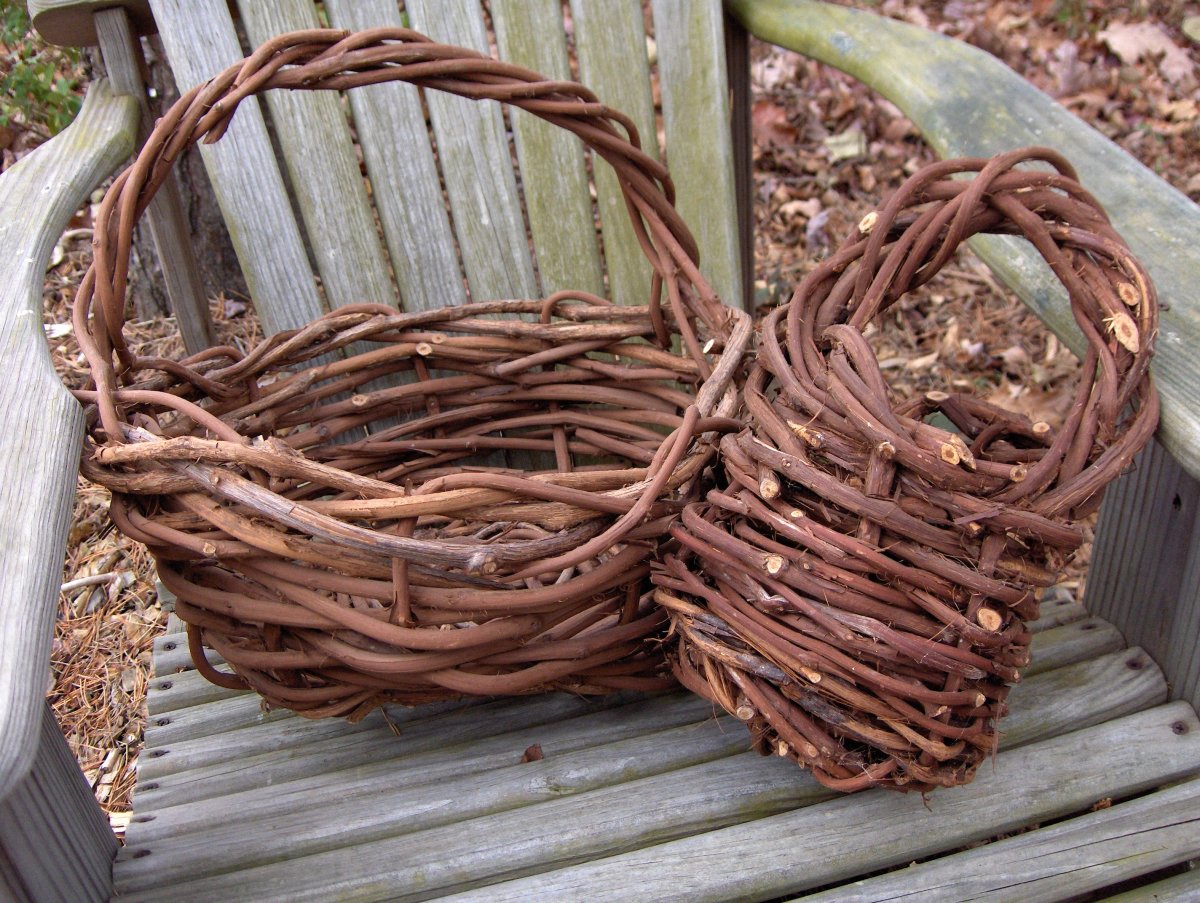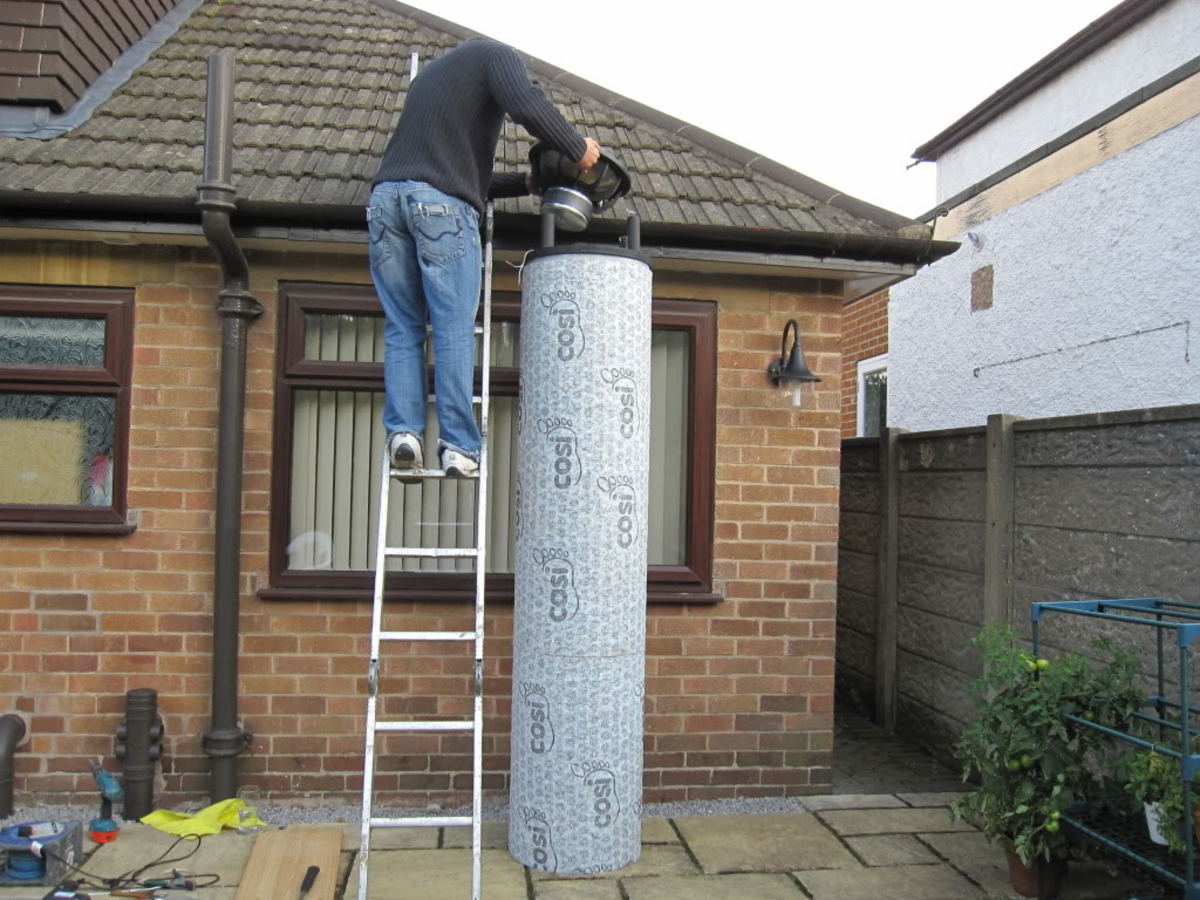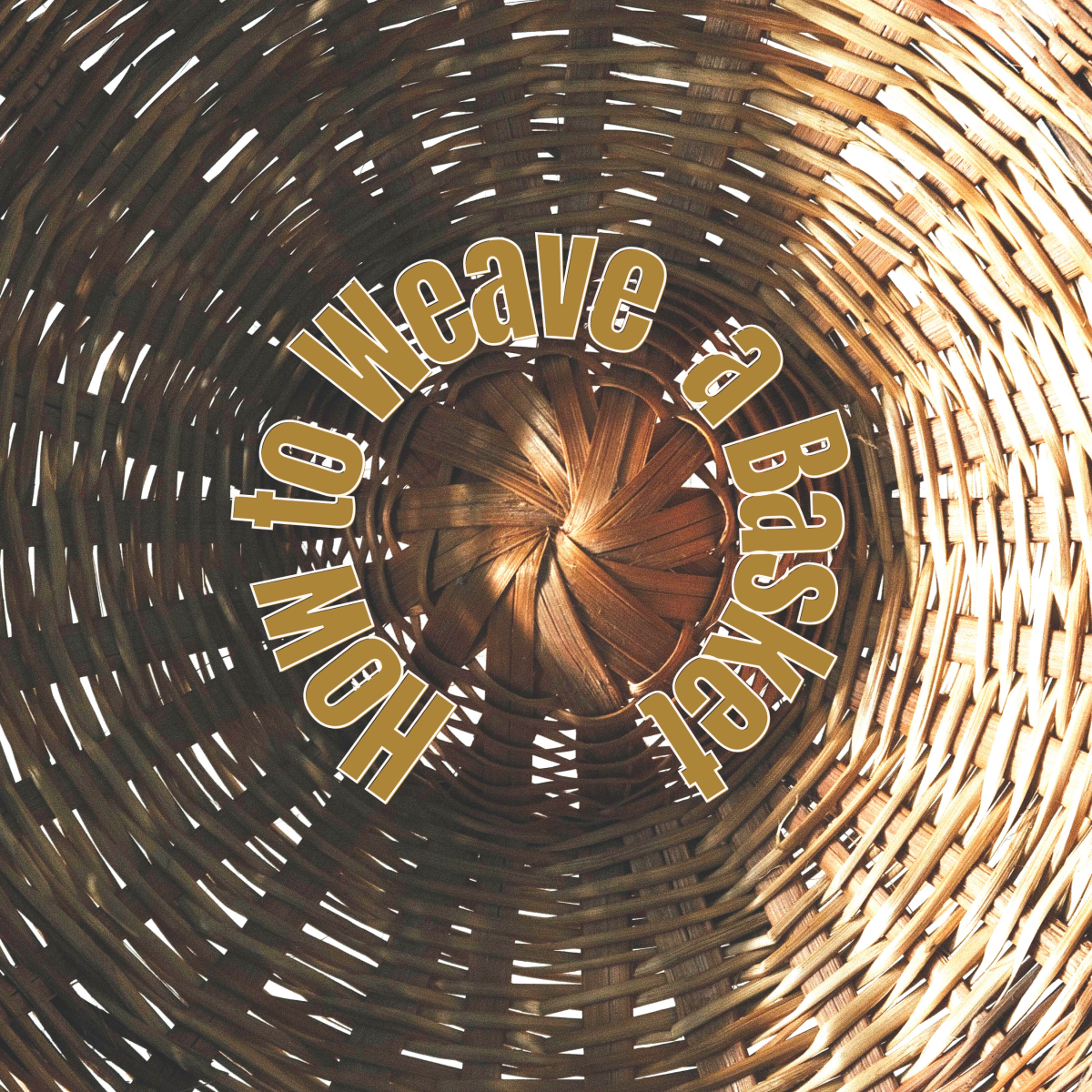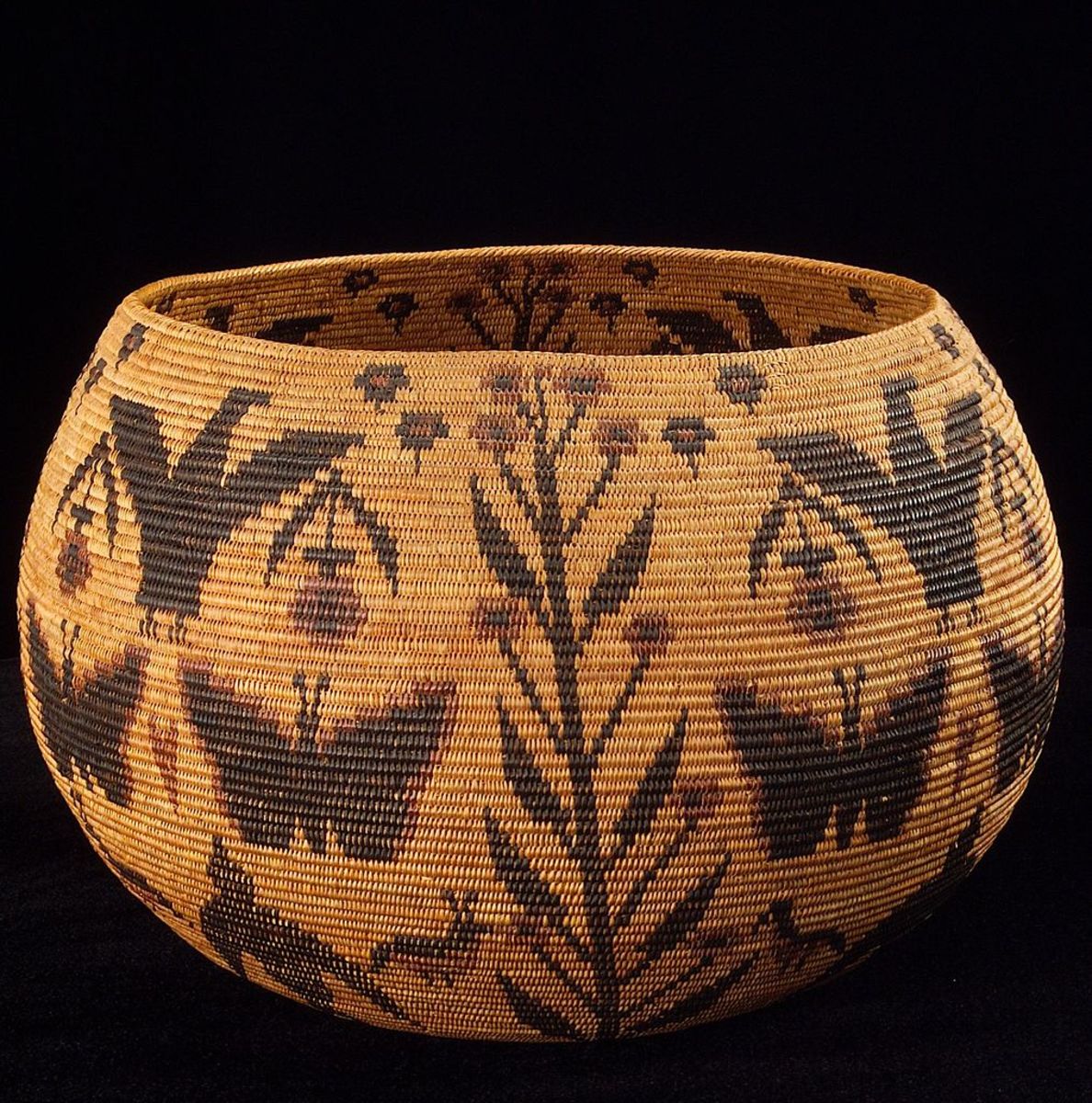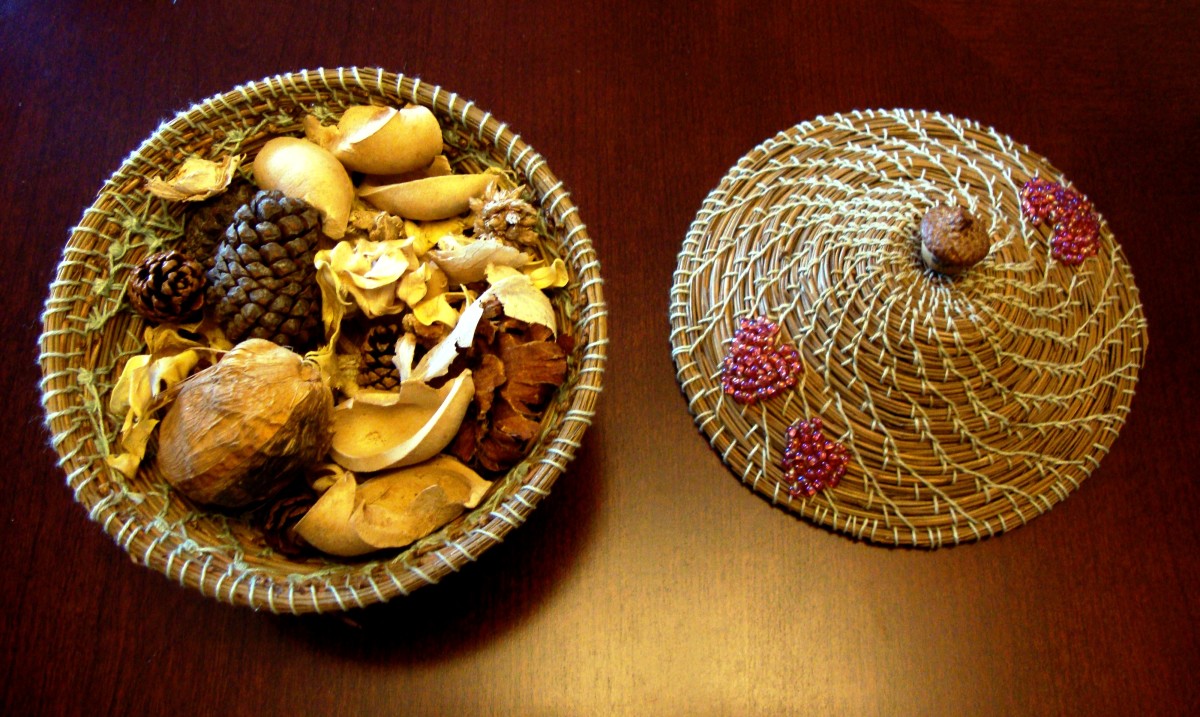How To Weave Baskets For Money And Pleasure
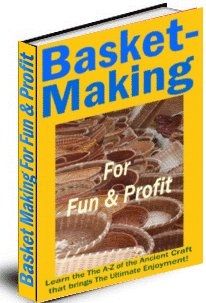
The Wonderful Craft Of Basket Weaving
Learn the The A-Z of the Ancient Craft of Basket Weaving, that will bring you The Ultimate Enjoyment for All Ages! Here on this page I wish to tell you about the art of Basket Weaving, how this wonderful craft can be relaxing and profitable......and all this in the comfort of your own home.
THE twisting and weaving of Nature's materials, grasses, twigs, rushes and vines, into useful and beautiful forms seems almost instinctive in man.
Perhaps it came to him as the nest-weaving instinct comes to birds-for at first he used it as they do, in the building of his house.
Later, shields and boats were formed of wicker work, but how long ago the first basket was made no one is wise enough to tell us.
Today Indian tribes in South America weave baskets from their native palms, South Africans use reeds and roots, while the Chinese and Japanese are wonderful workmen in this as in other arts and industries; but basketry has come down to us more directly through the American Indian.
Generations of these weavers have produced masterpieces, many of which are preserved in our museums, and the young basket maker need not go on long pilgrimages to study the old masters of his craft.
Here at last, the value of manual training is being realized, and basketry is taking an important place; following the kindergarten and enabling the child to apply the principles he has learned there.
He still works from the center out, and weaves as he wove his paper mats, but permanent materials have replaced the perishable ones, and what he makes has an actual value.
Basketry also fills the need for a practical home industry for children; so not only in school, club and settlement, but on home piazzas in summer young weavers are taking their first lessons.
Though they are unlearned in woodcraft, and have not the magic of the Indian squaw in their fingertips, they can, and do, feel the fascination of basketry in the use of rattan, rush and raffia.
It is hoped that this page may help in teaching you the craft and art of "Basket Weaving/Making for Money and Pleasure"
MATERIALS, TOOLS, PREPARATION, WEAVING - Materials

We shall use a great deal of rattan in making these baskets. It is a kind of palm which grows in the forests of India, twining about the trees and hanging in graceful festoons from the branches, sometimes to the length of five hundred feet, it is said, though seldom over an inch in diameter. It comes to us stripped of leaves and bark, and split into round or flat strips of various sizes, which are numbered by the manufacturer from 1 up to about 15, No. 1 being the finest as well as the most costly. Rattan can be bought (usually in five-pound lots) at basket factories in our large cities. Numbers 2, 3 and 4 are the best sizes for small baskets and 3, 5, and 6 for scrap baskets. Raffia, which is woven into small baskets, dolls' hats, etc., comes from Madagascar. It is a pale yellow material, soft and pliable, the outer cuticle of a palm, and can be bought at seed stores in
hanks of about a pound each. Either braided and used by itself or woven flat on rattan spokes, it is easily handled by very young children, whose fingers are not strong enough to manage rattan.
The flat or braided rush which is imported by wholesale basket dealers comes in natural colors, dull green and soft wood-brown. The flat rush is sold by the pound, and the braided in bunches of ten metres each. Woven on rattan spokes, it makes beautiful baskets. Braided rush is a good material for scrap baskets, while the flat, being finer, is successfully woven into candy, flower and work baskets. The leaves of our own cat-tail furnish a material almost as pliable and quite as attractive in color as the imported rush; in fact, Nature's storehouse is full of possibilities to the weaver with a trained eye and hand.
Fig 1 TWIST OF RATTAN
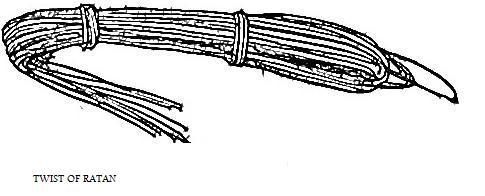
Tools
A Few Tools That Are Needed
A pair of strong, sharp shears, a yardstick, and a deep paper pail for water are needed at first, and later a short steel knitting-needle about the size of No. 4 rattan, and a sharp knife. Rubber finger guards for the right forefinger and thumb will be found almost a necessity where much weaving is done.
In raffia work, tapestry or worsted needles, No. 19, are required.
Fig 2 Under-And-Over Weaving

Preparation
How To Prepare For Basket Weaving
The rattan, as it comes from the manufacturer, is in long twists or skeins. (See Fig. i.) It should be drawn out, as it is needed, from the loop end; otherwise it will get tangled and broken. In preparing it, the spoke or heavy material which is to form the ribs of the basket(and which should be at least two numbers coarser than the weaver, except in small baskets, where a difference of one number is enough) is cut into lengths of the required number of inches. The weaver is wound into circles of about seven inches in diameter, the ends being twisted in and out several times to prevent unwinding. As rattan is very brittle, it should be put to soak, before using, for an hour in cold water, or fifteen minutes in hot. Rush will not need to soak as long, and raffia will become pliable in a few seconds.
Pairing
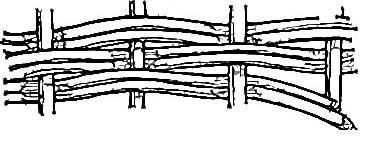
Weaving
Under And Over Weaving
Under-and-over weaving, the simplest form of all, is the one most used. Double weaving is done in the same way, except that two weavers are used at once. This is an effective weave on large surfaces, and in bands or patterns of the same or a contrasting color on plain rattan baskets. Pairing may be used either with an odd or even number of spokes. Two weavers are started behind two succeeding spokes, and crossed between them, so that what was the under weaver becomes the upper one each time. In the triple twist, three weavers are placed behind three consecutive spokes and brought in succession, starting with the back one, over two and under one spoke, each on its way to the back of the third spoke being laid over the other two weavers. In turning up the sides of large baskets where separate spokes or additional spokes have been inserted, or as a strong top for scrap baskets, this weave is invaluable. It entirely hides the spokes it crosses, and therefore is often used to cover places where broken spokes have been replaced.
Tripple Twist
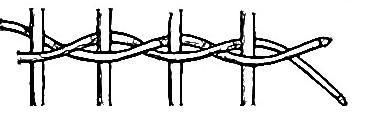
Raffia
RAFFIA AND SOME OF ITS USES
It is a rare thing to find a material at once so soft and so strong as raffia; and it could hardly be better fitted for the work of children's fingers if it was made for the purpose.
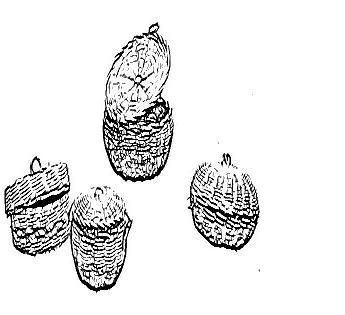
With a pound or two of raffia (there is about as much as this in one of the hanks that can be bought at seed stores or of dealers in kindergarten supplies), a paper of tapestry needles, a pair of scissors, and several flat sticks about a yard long and half an inch wide, you are well equipped. Given in addition to these some children fresh from the kindergarten training of eye and hand, and you can accomplish wonders. Indeed, so many charming things can be made from one of the great, yellow coils of raffia that it reminds one of the fairy tale in
which the little gnome spun a roomful of straw into gold for the miller's daughter. First of all, the children may braid some raffia, we will use so much of it in this form, and now, as later in rattan work, it is well for them to learn to prepare the materials they are to work with. Three single strands of raffia may be used in braiding, if the plait is to be very fine; two pieces of the raffia in each strand makes a better size for general use. If the raffia is slightly dampened before the braiding is begun, it will work more smoothly. The ends are tied together and attached to a hook or chair back, and then the child braids to the end of the strands or until they become thin and spindling, when other strands are laid in, always on the under side, so that the little ends will not show on the upper or right side.These ends may be cut quite close when the braid is done. It is hardly necessary to say that the braiding should be even and firm.
Knotted Work Bag
Here Is How To Make A Knotted Work Bag
Knotted Work Bag
Materials:
24 strands of raffia
a stick about a yard long and 1 ½ inches wide
a pair of scissors
a tapestry needle
The stick is held by the left hand at right angles with the body, the end resting on a chair or table. A strand of raffia is doubled and tied around the stick, as shown in Fig. 6, the knot being drawn up quite close. Twenty-four strands are knotted on in this way; they are then placed about an inch apart, and beginning with the inner one of the two strands nearest the workman, it is knotted, at about an inch from the first row of knots, with the strand nearest it in the next pair, making an even mesh. This is continued across the stick, and another row is knotted and another until ten or twelve rows have been made, when the work will tend toward a V shape (see Fig. 7, which for convenience is drawn with fewer strands). The stick is now slipped out and the bag finished (see Fig 8) by knotting first the two loose strands at the top together, then the two pairs following, and so on until the bottom is reached. The two sides are joined at the bottom by placing them with the meshes and knots evenly together and knotting two strands from the front and two from the back together each time in a last row of knotting. The ends of the raffia when cut to an even length make a fairly satisfactory finish, but the following is a better one: Wind a strand of raffia over a card, about two and quarter inches wide, five or six times, then slip it off and bind it around several times near the top with the end of the strand, sewing it fast with a tapestry needle; this forms a little tassel, such as are made of worsted. A row of these across the bottom of the bag, a cord of twisted raffia (as worsted cords are made), drawn through the top loops and an inner lining of turkey-red cotton will complete this pretty and serviceable bag.
Knotted Bag for Twine
Make Yourself A Knotted Bag For Twine
Knotted Bag for Twine
Materials: 17 strands of raffia,
A stick the size of a lead pencil,
A pair of scissors,
A ball of twine,
A tapestry needle.
It will be well to get your ball of twine before beginning this bag, to make sure of its fitting. A common lead pencil, provided it is a long one, will do quite as well as a special stick, and the raffia is knotted on it as described in the directions for a work bag, only there are seventeen strands instead of twenty-four; they are placed closer together, not over a quarter of an inch apart, and the rows of knotting are about a quarter of an inch from each other. When twelve rows are completed, the work is slipped off and finished as in the work bag. The bottom should be drawn up tightly, with a needleful of raffia, and a ball of twine of some bright harmonious color slipped in. A cord to gather up the loops at the top and a large tassel at the bottom will be the finishing touches to a dainty gift that any child may be proud to offer as his own work
Video On Basket Weaving - Split Whiteoak Basket Making
In this vidoe Westville's Woodwright shows how to make a whiteoak split basket.
Book-Mark
Here Is How To Make A Book-Mark
Materials:
1 spoke 10 inches long of No. 6 flat rattan,
3 spokes 31/4 inches long of No. 6 flat rattan,
1 strand of raffia,
A tapestry needle.
A book-mark that is pretty and easily woven is made on an Indian pattern, with the Indian arrangement of spokes and weavers. After soaking the spokes for an hour in cold water, the long spoke, No. I, is laid on a table vertically; No. 2, one of the short spokes, is then placed across it horizontally, at a distance of a little over an inch and a half from the end. Number 3, a short spoke, is laid across the other two obliquely, to the right of the upper end of spoke No. 1, and between it and the right end of spoke No. 2. Number 4 crosses from the left of spoke No. 1 obliquely, completing the star shape. A strand of raffia is doubled at its centre around spoke No. 1, with the ends toward the right. It is woven by pairing (see Chapter I) to a distance of one inch from the tip of each spoke, when the ends of the raffia are threaded through a worsted or tapestry needle and sewed off under the weaving, and the tips of the short spokes are cut in points.
Raffia Mat
Lets Make A Raffia Mat
Materials: 6 yards of braided raffia,
Several strands of loose raffia,
A tapestry needle,
A pair of scissors.
The braided raffia previously prepared now comes into use. A tapestry needle is threaded
with a fine strand of raffia, and the mat is begun by winding the end of the braid several times with the end of the strand which is threaded through the needle. A coil is then started with the end of the braid, the edge of the braid being up, not the face, and it is sewed through at least three braids at a time in stitches which run in the direction of the twists in the braid. The needle is run in slanting down from right to left and then up from right to left, forming a V within the coil. The mat is coiled round and round in this way till it is about four inches in diameter, when a border of the braid, sewed on in loops, completes it. These mats may be dyed or stained, or a large, colored bead is sometimes sewed in each loop of the border
Illustrated on a YouTube video - Vidoes on basket weaving
Here you will find vidoes on how to basket weave.
Dolts Hat
Dolts Hat
Materials: 2 yards of braided raffia, A tapestry needle, Several strands of loose raffia, A pair of scissors.
The idea of making her own doll's hats will be a delightful and novel one to the small girl, and hats of all sizes and shapes are possible when she has
once mastered the sewing together of the braided raffia. Just as in large hats we will start with the very centre of the crown, and that is coiled and sewed in the same way as the raffia mat was done, till it is an oval mat about one and a half by two inches; the coil of braid is then brought round with its upper edge just below the centre of the previous row. The next row is sewed around in the same way and the next until the crown is the desired height. We shall have to be careful to draw the braid tight, and in sewing to make the stitches run like the twists in the braid so that they will show as little as possible. The brim is made by flattening out the braid and letting it go more easily, taking care, however, to see that it overlaps the last row nearly to the centre of the braid in each case. When the brim is about an inch wide, one or two rows are drawn quite tightly as they are sewed on, which gives a roll to the edge of the brim, and it is finished by sewing the end of the braid firmly down on the under side of the brim. Many soft raffia baskets, oval and round, can be made on the principle of the crown of this hat, and we shall learn in subsequent chapters how to make more elaborate baskets of this material.
MATS AND THEIR BORDERS
MATS AND THEIR BORDERS
THE centre, which forms the bottom of the basket is the starting-point, and it is such an important part to master that we will make at least two centres in the form of mats before beginning a basket.
Mat with Open Border No. I
Materials:
4)x 12-inch spokes of No. 4 rattan,
1)x 7-inch spoke of No 4 rattan,
2)x 1 weaver of No. 2 rattan.
The four spokes, arranged in pairs, are crossed in the centre, the vertical ones being uppermost or nearest the person weaving; and between the upper halves of these vertical spokes the half spoke seven inches long is placed. These are held in position by the left hand, which is, as always, the one that holds while the right is the weaving hand. An end of the weaver previously unwound is placed along the horizontal spoke back of the vertical ones with the end toward the right. The forefinger of the right hand now presses the weaver across the upper vertical spokes and down behind the horizontal ones on the right (thus binding the end of the weaver securely), next over the lower vertical spokes, and behind the horizontal ones on the left (see Fig. 9). This is repeated, and then beginning with the upper vertical spokes, the spokes are separated and the weaving begins (see Fig. 10). A common fault of beginners is to pull the weaver from a distance of several inches from the work; instead it should be pressed with the forefinger, under and over the spokes, as close to the work as it is possible to get it. The spokes should be very evenly separated- this is something that the beginner cannot be too careful about, as upon it so much of the symmetry and strength of his baskets will depend. It may help him to think of the regular spaces between the spokes of a wheel and how much trouble one badly placed spoke would make. When there is just enough weaver left to go around once, the binding off is begun. This is a process much like overcasting. After going under one spoke and over another, the weaver is passed under the last row of weaving just before it reaches the next spoke, it then goes behind that spoke, in front of the next and under the last row of weaving before the next spoke. When a row of this binding is completed, the mat is finished with
Open Border No. 1-After cutting the spokes to a uniform length with a slanting cut (so that the point may be easily pushed down between the weavers), the spokes should be held in water for a few minutes. When quite pliable, spoke No. 1 is pushed down beside spoke No. 2, No. 2 beside No. 3, and so on around the mat, taking care that at least an inch is pressed below the edge of the mat.
Video On How To Make Gift Baskets - Easy Gift Baskets To Make
In this vidoe you will see how to make gift baskets, which you could either sell or give as gifts. You can use these ideas to fill your baskets that you make.
MATS AND THEIR BORDERS
Mat with Two Weavers and Open Border No. 2
Materials:
4 14-inch spokes of No. 4 rattan,
8-inch spoke of No. 4 rattan,
weavers of No. 2 rattan.
This mat is started like the first one and woven in the same way until the end of the first weaver is reached, when another is joined to it by simply crossing the weavers, at an inch from the end of each, back of a spoke (See Fig. n). The ends may need to be held, or replaced in position while weaving one row after which they will keep their places and may be cut shorter when the mat or basket is finished and dry. This method of joining weavers has the advantage of not showing on the right side of the work. When the end of the second weaver is reached, bind off as in the first mat and finish with.
Open Border No. 2.-Spokes at least four inches long, measuring from the last row of weaving, are required for this border. Cut and soak as described in Open Border No. 1. Spoke No. 1 crosses No. 2 and is pushed down beside No. 3. Number 2 crosses No. 3 and is pushed down beside No. 4 and so on around the mat.
Even these first little mats are useful to put under a tea-pot on the table, or two tied together with ribbons or with their borders interlaced will make a serviceable whisk-broom holder.
THE SIMPLEST BASKETS
How To Make The Simplest Baskets
IN weaving the first baskets, while the worker is getting familiar with his material, he should copy such simple forms as are shown in the plate. The working out of his own ideas will follow later.
Basket with Open Border No. I
Materials:
4 14-inch spokes of No. 3 rattan,
8-inch spoke of No. 3 rattan,
weavers of No 2 rattan.
Begin as in the directions for a mat, and when the centre or bottom of the basket is about two inches in diameter, wet the spokes and bend them sharply upward, remembering always that the side toward the person weaving is the outside of the basket, and that the weaving should go from left to right. This is something that even skillful young workmen sometimes need to have impressed upon them. The bottom of the basket should be placed on the knee with the side which in starting was toward the worker turned down, the bent upward, and the weaving done in that position. In weaving up the sides of the basket, the middle finger of the right hand presses down each spoke behind which the weaver has to go, while the thumb and forefinger bring the weaver along behind it. Two weavers are used, and they are joined by simply crossing them, at an inch from the end of each, behind a spoke. After binding off, finish with Open Border No. 1.
Basket with Rounding sides and Open Border No. 2
Materials
4 14-inch spokes of No. 3 rattan,
8-inch spoke of No. 3 rattan,
weavers of No. 2 rattan.
Having made a bottom about two inches in diameter, wet the spokes and turn them up, rounding them by bending them over the middle finger. The first weaver should not be drawn too tight, but allowed to go easily, though pressed closely down upon the weaving just below it. Before the middle of the second weaver is reached the spokes should be gradually drawn closer together by a slight tightening of the weaver; this should continue to the end of the weaver. Bind off and finish with Open Border No. 2. This is an important basket in teaching the effect of a loosely and a tightly drawn weaver. Both this basket and the one with straight sides make pretty candy baskets, especially when they are dyed or stained attractively; see finishing touches
Stand for Pens and Pencils with Open Border No. I
Materials:
4 14-inch spokes of No. 4 rattan,
1 8-inch spoke of No. 4 rattan,
2.5 weavers of No. 2 rattan.
Any child who has successfully made the mats and baskets already described will be able to form this stand and it will interest him to see how useful it will be on someone's desk.
After weaving a centre almost two and a quarter inches in diameter, the spokes are turned sharply upward, and the weaving of the sides is begun; this will be a little harder than the weaving of the first two baskets because the sides should be kept perfectly straight all the way up. To do this there must be an even pressure on the weaver, neither too tight nor too loose, and the spokes must be kept the same distance apart from the bottom to the top. The spoke material being heavier than in the other baskets helps to keep the sides firm. Two weavers and part of a third are used; the edge is then bound off and Open Border No. 1 finishes it.
Basket Weaving Books



COVERS
IN weaving larger baskets the number of spokes as well as their length must of course be increased and in order to accustom himself to the handling of these extra spokes the worker is advised to make a
Large Mat with Open Border No. 2
Materials: 6 16-inch spokes of No. 4 rattan, I 9-inch spoke of No. 4 rattan, 3 weavers of No. 2 rattan.
Three vertical and three horizontal spokes are arranged as in the first mat, and the half spoke (so called for convenience but which is, as always, one inch longer than half the length of the others, to allow for binding) is placed between any two of the upper vertical spokes. It should never be on the outside of the group. A weaver is started and bound around three times, the spokes are then separated and the weaving begins. Three weavers are used and then the mat is bound off and finished with Open Border No. 2.
The child who does not appreciate mats will be entirely won over when he sees some of the fascinating things that can be made with them. For example a tiny wicker table just the size for a doll's house and the shape for an afternoon tea!
Doll's Table of Rattan
Materials: 6 22-inch spokes of No. 3 rattan, I 12-inch spoke of No. 3 rattan, 1 weaver of No. 2 rattan, A piece of fine wire 2 or 3 inches long, Raffia, A knitting needle.
Two groups of spokes, one of three and the other of three and a half, are crossed in the centre and woven into a mat, which when it is three and a half inches in diameter is bound off. Each spoke is brought across the next one and pressed down beside the next as in Open Border No. 2, with the difference that the long end is not cut off, but brought out between the fourth and fifth rows of weaving on the under side of the mat. The border is drawn in so that it will not be over a quarter of an inch beyond the weaving, The long ends of the spokes (which are to form the legs of the table) are brought together and bound with a piece of fine wire just under the centre. They are then separated into three groups of four each. The odd spoke is either cut off or whittled very thin and bound in with one of the three groups. A strand of raffia, either double or single, is now started at the top of one of the groups and wound tightly around until it has covered the desired length. At the end a half hitch, or one button-hole stitch, is made to keep the raffia from slipping and then it is wound up again to the top. It is brought down the second leg as far as the first one was wound, then it is turned with a half hitch and brought up again in the same way. The third leg is also wound down and up again with a half hitch at the bottom to hold it. After this third leg has been covered the raffia is brought in and out between the legs where they separate in order to spread them more effectually. It is then tied and the ends cut close. Finally the spokes at the end of each leg are cut to a uniform length, and slanting, so that the table will stand firmly.
Doll's Chair of Rattan
Materials:
6 20-inch spokes of No. 3 rattan
I 11-inch spoke of No. 3 rattan,
4 10-inch spokes of No. 3 rattan,
1 piece of No. 3 rattan about 9 inches long,
2 weavers of No. 2 rattan,
Raffia
A knitting needle
Again the mat comes into play. This time as the seat of a miniature high backed chair made of rattan. Groups of twenty-inch spokes, one of three and the other of three and a half, are crossed in the centre, bound around twice with a weaver of No. 2 rattan and woven into a mat three inches in diameter. Each spoke is brought down beside the next one, as in Open Border No. 1, except that the long end is threaded through between the second and third rows of weaving on the under side of the mat. When all have been brought out in this way underneath the mat, or seat, the four groups of three ends each which are to form the legs, should be so divided that the vertical spokes in the centre of the chair seat shall run toward the front and back of the seat. The thirteenth spoke is whittled to a thin point and bound in with one of the other groups, which are wound with raffia down to the end, turned with a half hitch and then brought up again. A neat way to start the raffia is to thread it across a row of weaving just above the group it is to bind. A ring of No. 3 rattan about nine inches long is coiled and held within the space enclosed by the legs, about half way down, where it is wound around with a strand of raffia and bound securely to each leg The back of the chair is formed by inserting a number of spokes of No. 3 rattan, ten inches long beside those in the seat and at that part of the seat which has been chosen for the back. It is woven back and forth with No. 2 weaver. Needless to say the weaver must be a very pliable one in order to make the sharp turns that are necessary on the sides. Individual taste and skill here has an excellent opportunity to show itself, and an ingenious child will find that he can construct almost any kind of a back he chooses. The outside spokes of the chair back in the picture are each brought over and down beside the other one; while the inner spokes are crossed in the centre and run down beside the outer spokes, forming a narrow, oval back which is woven back and forth as far up as the crossing of the inner spokes. If arms are desired more spokes will be necessary. In this case the outer spokes are woven in with the others for a few rows and then bent over and forward to form the arms. They are cut to the desired length and each is inserted beside one of the side spokes in the seat. Having exhausted, for the present, the possibilities of the mat we will return to the real subject of the chapter-covers, with apologies for the digression.
Small Round Basket with Slightly Rounded Cover
Making Small Rounded Covers
Materials:
BASKET-6 16-inch spokes of No. 4 rattan,
1 9-inch spoke of No. 4 rattan,
4 weavers of No. 2 rattan.
COVER, HINGE, ETC.-6 14-inch spokes of No. 4 rattan, 1 8-inch spoke of No 4 rattan, 1.5 weavers of No. 2 rattan, A knitting needle.
The bottom is woven in the same way as the large mat, to a diameter of one and three-eighths inches; when the spokes are wet and rounded up over the finger. The sides are woven with loosely drawn weavers until three have been used. The fourth weaver is drawn tighter so that the basket shall be somewhat the shape of an orange with the top Cut off. The edge is bound and finished with this border. The spokes are soaked until pliable, and each is brought back of the next one on the right and then out. This goes on around the basket. The end of each spoke in turn is then brought over the first spoke on the right, and pressed down inside the basket just behind the second spoke on the right and next to the weaving.
The cover is woven like the bottom, except that from the very centre the spokes are bent gradually up. One full-length weaver should make a large enough cover. It is then bound off and finished with a Rope Border. Each spoke in succession is brought across the next spoke to the right and then inside the cover. When the circuit of the cover has been made, each end of a spoke is brought across the next spoke to the right and then pressed down inside the cover where, after the border is finished, they are cut just long enough to allow each end to lie across the next spoke.
Fastenings. Three rings of No. 2 rattan are made as follows. A piece of rattan about a foot long, which has been soaked until pliable, is tied into a ring. The ends are then twisted in and out once around the foundation ring (see Fig. 12), or when a heavier ring is required, twice or three times. One of the rings should be smaller than the other two, and none of them need be over three-quarters of an inch in diameter. The smallest one is attached to the cover in front, across a spoke and between the border and the last row of weaving, each end being sewed off under a spoke, then over one and inside the cover, where it is cut off. Another ring is attached in the same way at the back of the cover, and the third one is fastened across a spoke in the front of the basket, between the third and fourth rows of weaving. To complete the hinge the cover is put in position so that the ring at the back of the cover will be just above a spoke on the basket. The end of a small piece of No. 2 weaver is then pressed in between the third and fourth rows of weaving to the left of the spoke referred to, and brought out on the right of the spoke. The ends are then crossed, brought through the ring on the cover, and drawn up just tight enough to allow the cover to close easily. The end which started on the left of the spoke is brought to the right and fastened, as the rings were, between the border and the last row of weaving on the basket, while the end which started from the right of the spoke crosses to the left, and is fastened in the same way between the border and the last row of weaving. If desired this basket may be varnished, see finishing tourches.
Green Rattan Basket with Flat Cover
How To Make A Green Rattan Basket with Flat Cover
Materials:
BASKET-8 i6-inch spokes of No. 4 rattan, I 9-inch spoke of No. 4 rattan, 5.5 weavers of No. 2 rattan.
COVER, HINGE, ETC.-6 16-inch spokes of No. 4 rattan, 1 9-inch spoke of No. 4 rattan, 4 weavers of No. 2 rattan, A knitting needle.
This -is an excellent shape for candy or for a small work basket and though it is so simple if it is well made and colored the result is most satisfactory. The basket is started with eight sixteen and one nine-inch spoke of No. 4 rattan, bound three times with No. 2 weaver and woven into a bottom three inches and a quarter in diameter. The spokes are then wet and rounded up into a bowl shape which, when five weavers have been used in under-and-over weaving, should be drawn in gradually with the remaining half weaver until the top of the basket is five and a half inches in diameter, It is then bound off and finished with this border. Each spoke is brought over the next one on the right and pressed down inside the basket where, after the border is finished, the ends are cut just long enough to allow each to lie against the spoke in front of it.
The cover has two groups of sixteen-inch spokes, one of three and the other of three and a half which are crossed in the usual way and bound three times. It is woven like the large mat until its diameter is about five inches when the edge is bound off and finished with the Rope Border already described in (Rattan Scrap Basket with Broad Band Near the Base)
The hinge and fastening are made as follows. Having chosen the best place for the hinge on basket and cover an end of a piece of No. 2 rattan, about a foot long, (which has been wet until pliable) is inserted at the right of a spoke and under the last row of weaving on the basket. It is then woven under and over two or three spokes to fasten it securely. The long end is crossed diagonally-over the border of the cover and pressed in between the last two rows of weaving at the left of a spoke. It is then brought down inside and out again at the left of the spoke on the basket and across to the right of the spoke in the cover, where it is pressed inside and down to the place where it started on the basket. Here it is woven under and over several spokes till it is firmly attached. The front fastening is formed of two rings, also made of No. 2 rattan, see page 39. The ring on the cover should be smaller than the one. on the basket so that it may slip through it. In attaching the one on the cover, the ends are pushed inside the basket between the border and the last row of weaving, and woven under and over two or three spokes until the ring is secure. The ring on the basket is fastened in the same way, except that the ends are inserted between the fourth and fifth rows of weaving from the top, one on either side of a spoke. The basket is then colored pale green, see finishing touches.
Basket with Overlapping Cover
How To Make A Basket with Overlapping Cover
Materials:
BASKET-8 18-inch spokes of No. 3 rattan,
1 10-inch spoke of No. 3 rattan, 4.5 weavers of No. 2 rattan, 6 strands of raffia, braided.
COVER AND RING-8 16-inch spokes of No. 3 rattan, I 9-inch spoke of No. 3 rattan, 4 or 5 weavers of No. 2 rattan, 6 strands of raffia, braided, A knitting needle.
Before beginning this basket the raffia will have to be braided, as described in Chapter II, into two pieces of equal length; one for the band on the basket and the other for the cover. The bottom of the basket is woven, slightly raised in the centre, to a diameter of four and a half inches; the spokes are then wet until pliable and turned sharply upward. Straight sides are woven of half an inch of triple twist, then three rows of braided raffia and another half inch of triple twist, which should end at the same place on the circumference of the basket as it began.
In ending, each weaver is cut just long enough to allow it to be pressed down beside the next spoke for about half an inch below the edge of the basket. The border is woven from right to left (instead of left to right as is usual in closed borders), which makes it harmonize better with the triple twist. Each spoke is brought under the spoke to the left, over the next spoke and down inside; the beginning of the border being left open so that the last spokes may be easily woven in.
Cover.-Eight and a half sixteen-inch spokes are divided into two groups, one of four and the other of four and a half, and started in a flat centre which is woven to a diameter of an inch and three-quarters. The braided raffia is then joined to the rattan, by crossing the ends back of a spoke, and woven into four rows. The rattan is then started again and continued in under-and-over weaving until the cover is five inches in diameter when the spokes are thoroughly wet and turned sharply upward. Seven-eighths of an inch of triple twist is woven into straight sides for the overlapping cover. It is finished with a border in one row, woven from right to left as was the border of the basket. Each spoke is brought over the next spoke, under the succeeding one and then out, where it is cut, after the border is made, just long enough to allow the end to lie against the spoke in front.
A ring, not quite an inch in diameter, of No. 2 rattan twisted around three times, is a necessary addition. It makes a sturdy little handle with which to raise the cover. After the ends have been twisted around the circumference of the ring as described elsewhere in this chapter, they are inserted, with the aid of a knitting needle, one on either side of the vertical spokes in the very centre of the cover, and woven under and over one or two spokes till firmly fastened, when they are cut off on the inside.
HANDLES
Small Basket with Twisted Handle
SUCH handles as are described in this chapter are simple and quite possible for the beginner to make. Others that are more elaborate will be found in the chapter on Oval Baskets.
Small Basket with Twisted Handle
Materials-
BASKET 6 16-inch spokes of No. 4 rattan,
1 9-inch spoke of No. 4 rattan,
2 weavers of No. 2 rattan,
HANDLE-1 12-inch spoke of No. 4 rattan,
1 weaver of No. 2 rattan, A knitting needle.
Six spokes and a half are started as in the large mat and woven into a centre, which should be pressed up in the middle into a concave form like the bottom of a wine bottle. Beginners often find it hard to make a basket that will stand well. The tendency seems to be to form a rounded bottom rather than one that is perfectly flat. A bottom that is slightly concave is not so difficult to make, and answers the purpose as well as a flat one. When the bottom is two inches in diameter the spokes are wet and bent upward and woven with flaring sides. Two weavers are used, and then the basket is bound off and finished with a closed border.
After wetting the spokes until they are pliable the border, which is in two rows, is begun. The first spoke is brought behind the spoke to the right of it and then out, leaving a space between the basket and the first spoke. The second spoke is brought behind the one to the right of it and then out in the same way, except that it is pressed close down upon the basket. Each spoke in turn is brought back and out until there is only one left erect. This spoke is brought behind the first spoke, out between the first and second spokes and pressed close down upon the weaving. In the second row each spoke is brought behind the succeeding one on the right and then out, making a roll on the edge of the basket with the ends outside. These ends are cut slanting, just long enough to allow each to rest on the spoke in front of it.
Handle.-The knitting needle is run down beside a spoke and then drawn out leaving room to insert an end of the twelve inch spoke, which should be pressed down at least an inch below the top of the basket. The other end of the spoke is then inserted in the same way beside a spoke exactly opposite where the first end was placed. This makes the foundation handle. The end of a pliable weaver is now inserted under the third row from the top of the basket to the left of the foundation handle and run up between the weaving. This weaver is twisted around the handle with twists about an inch and a half apart (experience will soon show that twists too near together will make an uneven handle and those too far apart one that is not firm and strong). At the opposite side of the basket the weaver is pushed in, under the third row of weaving from the top, on one side of the handle and brought out again on the other side of the handle three rows from the top, making a loop inside. The weaver is then laid close beside the first twist, and follows it across to the opposite side, where it goes in under the third row on the left of the handle and comes out on the right side. Each row of twisting must follow close beside the last and six, or at most seven, rows will cover the spoke. The weaver is fastened off by bringing it inside the basket, then out across a spoke and inside the basket again where it is cut short.
More patterns to follow
CONCLUSION
1) This page was made for anyone wishing to know a little more about basket weaving, It is hoped that you understand a bit more and willing to go out there and give it a try.
2) You would have also found the basic steps and patterns for making baskets.
3) There is no doubt that basket weaving is an art, but like anything it can be learnt. I promise it is not as hard as you might think.
4) There is a lot more on basket weaving and what can be done with the baskets that you make. I hope to be covering more about this fabulous craft in later lenses.
5) The point to remember is that the only thing holding you back is your mind.
6) This craft can be a great way for you to relax and earn you a living from the comfort of your own home.
My Lenses
Please Visit My Other Lenses
CLICK THE LINKS BELOW TO GO TO THE LENS YOU WANT

